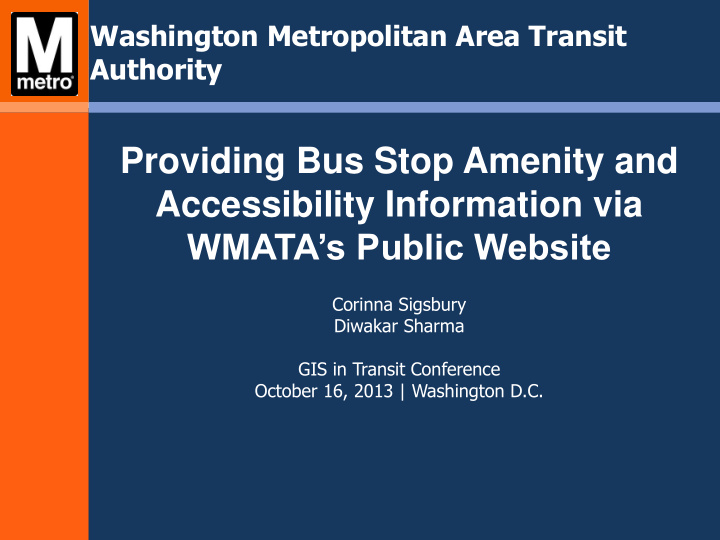



Washington Metropolitan Area Transit Authority Providing Bus Stop Amenity and Accessibility Information via WMATA’s Public Website Corinna Sigsbury Diwakar Sharma GIS in Transit Conference October 16, 2013 | Washington D.C.
Need for Project • Approximately 11,100 bus stops in the District of Columbia, Maryland, and Virginia. • All buses in the Metro fleet are accessible. • MetroAccess is a shared-ride, door-to-door paratransit service for people whose disability prevents them from using bus or rail. – 30,000 eligible customers • Give customers familiarity with stops before they travel.
Bus Stop Information Format • Application will be available on WMATA.com • Show photos, maps, and information related to universal and accessible design features. • Data was collected by surveys • Information is stored in GIS database
Give Customers Information about Bus Stops using GIS Data • This tool will give customers the information they need about bus stops along their trip in order to use fixed route with confidence. – Accessibility design elements – Universal design elements • The Bus Stop Information application is ready for website integration and internal beta testing.
How to access on WMATA.com • Access to this application will be on public website: – Trip Planner – Accessibility dropdown – Bus dropdown • Application will fit within WMATA website frame, and match WMATA website colors and styles.
Application • Site specific photos from WMATA database. • Bus stop information will be in the same format for all stops. • Map from WMATA database. • Links for external sites with other maps and photos. • Survey date.
Application • Navigate to other stops. • Customers may help update information by “Report a Problem” link. • Section 508 of the Rehabilitation Act of 1973 compliance Hovering over the text will • give a full sentence text description for screen readers. Testing by external • organization.
Current Application Stage Planning Requirements Maintenance Analysis Implementation System Design & Test
Design Challenges • Should meet Accessibility requirements • 508 compliant • Easy to read and understand GIS data • Images, Text, Map • Visually outstanding • Block design • Blend and Fit within existing website • Color Scheme, Application extent
Implementation Challenges • Choosing Application platform • ArcGIS API for Flex • ArcGIS API for JavaScript • ArcGIS API for Silverlight • Should be device independent • JavaScript, HTML, CSS • Combining inputs from different data sources GIS and non-GIS data •
Integration Challenges • Hand-off from main non- GIS website “www.WMATA.com”
Next Steps • Integrate application with main website and perform beta testing. • WMATA internal involvement and marketing. • Comments from external focus groups. • Continue to update the data source with ongoing surveys of the bus stops. – Data collection ranges from 2007-2013. • Release to the public summer 2014.
Questions Washington (DC) Metropolitan Area Transit Authority Diwakar Sharma, dsharma@wmata.com Corinna Sigsbury, csigsbury@wmata.com
Thank You !
Recommend
More recommend